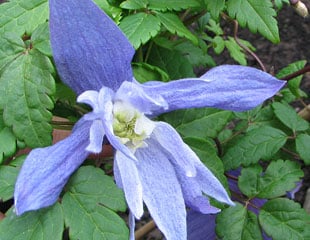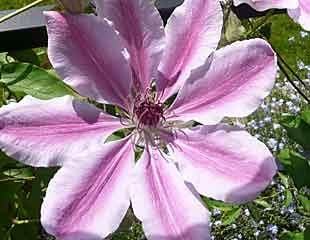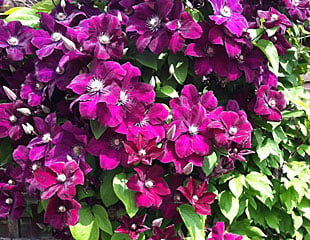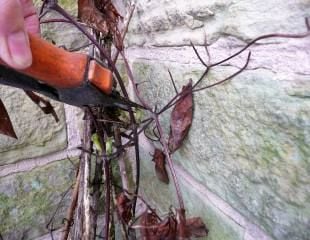


How to Prune Clematis
How and when to prune Clematis raises concerns for gardeners. As with all pruning, do it at the wrong time, and you may prevent flowering, which means "when" is as important as "how".
Why prune Clematis?
A clematis left unpruned will, obviously, grow taller and taller, but importantly, all the flowers will be at the top of the plant, almost out of sight. Pruning keeps the Clematis to a manageable size, produces more flowers and where you can see them.
The first step in pruning a Clematis is to decide to which group it belongs: 1,2, or 3.
Step one - Which Pruning Group is my Clematis?
Clematis pruning groups 1, 2 & 3 explained:
Dead easy if you have the label. What if the label disappears, or you've a garden that already has an unidentified Clematis?
Key Points:
Group 1: Follow the old gardening saying, "If it flowers before June, don't prune." This applies equally to Clematis. Those Clematis which flower early in the year ( as in before June) from February until early May, are going to be Clematis alpina, macropetala and montana. For pruning purposes, these are all 'Group 1'. The flowers are on growth made the previous year ( old wood), which means this type of Clematis must not be pruned early or you will cut off the buds and branches on which the flowers are forming, and cut off the potential flowers. This group 1 Clematis do not require routine annual pruning and will flower happily without pruning. If needed, prune Group 1 after flowering to tidy it up or keep it within a growing space.
Group 2: The next group of Clematis is very popular and the most commonly grown. You can identify a group 2 Clematis by the fact that it flowers in early summer, May and June. This group includes varieties such as 'Nelly Moser', (Image above centre) 'The President Niobe' and are all known as "Group 2"
Group 3: The third group is the late-flowering Clematis. These are a bit confusing because some Clematis in this group have large flowers, such as 'Jackmanii' (illustrated above), and others can have small flowers, such as C. viticella. Though the flower sizes vary, gardeners can distinguish them because they all flower late in the season, and we know them as "Group 3".
Make a note of when in the year your Clematis flowers, and you can make a judgment on how to prune it.
Early spring flowering is group 1; summer flowering is group 2, and late summer flowering is group 3. This is a broad-brush approach, as the only fail-safe way is to identify the precise variety of Clematis, and then to check which pruning group it belongs. Since there are hundreds of types of clematis and new ones being bred all the time, identification this way is not always easy.
What if you just don't know what type of Clematis you have?
How to prune an unknown variety of Clematis
It may be that despite your best efforts, you cannot be sure what type of Clematis you have. This is quite common when you move and inherit a garden, and it has established Clematis, but you have no idea what type.
It's frustrating. This video makes suggestions on how you can best prune an unknown variety of Clematis.
Step 2 How to prune different types of Clematis
Videos: pruning groups 1,2, & 3 explained
and How to prune Clematis Group 2 and 3
Pruning groups 1,2 & 3 explained and how to Prune them
How to prune Group 2 Clematis, the summer flowering varieties of Clematis
How to prune Group 3 Clematis, the late summer flowering varieties
Group 1, the early flowering species, which include C. Montana C. alpina, and C. macropetala. As a group, they require little or no pruning. These Clematis will benefit from a light trim after flowering. Some C.montana are vigorous and may need pruning to contain them in the growing space, in which case, prune back to the size you want, after flowering, which will be late May. Avoid pruning after June, as the Clematis is then producing wood (and flowers) for next year. Clematis in Group 1 can be left unpruned. Clematis montana is a popular variety as it flowers reliably and requires no pruning, so it is one of the easiest Clematis to grow. (see Types of Clematis.)
Group 2 early to mid-season flowering (below centre image) This group of Clematis require moderate pruning to a framework. Prune Group 2 Clematis lightly to a framework of branches and buds, at a height of 50cm to 90 cm, depending on the buds on the stems, to create a framework. Avoid pruning too hard, as this may reduce flowering. As these clematis flowers in early summer, during late May and June, prune in late February/early March.
Prune off the top growth to a pair of axil buds to make a framework, cutting back, not harshly, to a good pair of axil buds. You may remove quite a bit of top growth; some may have buds and shoots, don't worry, that's normal. Just lightly cut back to a good framework and remove any spindly or poor shoots.
In the images, the stems of the Clematis in Feb/March look dead, all brown and stringy. In the second image, the Clematis in winter looks dead. It definitely is not. Locate the axil buds shown in the second image and in the third image, prune back to axil buds and cut off top growth. By pruning time, February or early March, Clematis are already growing and the top of the plant, in particular, will have buds and shoots on it. Do not worry that when pruning that you are cutting off this new growth; plenty more will follow.
Group 3 are the late flowering cultivars, and small flowering cultivars With the late flowering group of clematis, pruning is easier, simply cut down to about 30 cm in Feb/early March.
Group 3 Clematis tend to be vigorous and need to be pruned hard every year. A reservation about this variety of Clematis is that they are vigorous and can quickly outgrow their space.



What goes wrong when pruning Clematis?
Q & A
Is it too late to prune my Clematis? Ideally, you should prune clematis within the pruning window, which for Groups 2& 3 is mid-February to early March. At a push in March, but bear in mind the later you prune, the fewer the flowers. You can prune at any time of year, but you risk sacrificing the flowers.
My Clematis has flowers, but they are all at the top. What can I do? When this happens, the Clematis has not been pruned hard enough. When you next prune, cut it back harder.
I have no idea what variety of Clematis I have. How should I prune it? Treat it as a group 2, see the video advice above.
I think I pruned my Clematis at the wrong time; it has not flowered this year. What should I do? Leave it alone until next February and then prune according to group, or if you don't know, treat it as Group 2.
I have a Clematis Montana, which is getting out of hand. How do I prune it? You can prune it hard after flowering. See How to prune a Clematis montana.
How to prune a New Clematis
As you may expect, pruning a new clematis is slightly different to an established plant. You have purchased a lovely Clematis, planted it carefully, and the question is, how to prune it when it is new?
All newly planted Clematis are pruned in the same way. You want to make the immature plant produce a number of stems. It depends on the state of the Clematis when you buy it. If the plant already has multiple stems, that is 3-5 stems, growing from the base, it does not need pruning as it's already in good shape. This is often the case if the Clematis purchased is more mature.
If the new clematis is formed by just a single stem, prune it back hard the first spring, February/March, to a pair of buds around 30cms from the ground. Within a short period, it will throw out new shoots which can be trained into shape. After the first year, prune according to its group.
